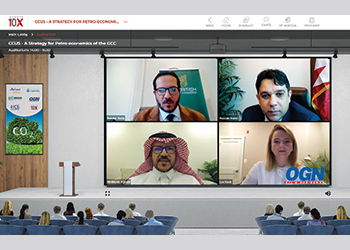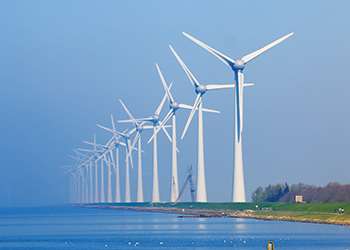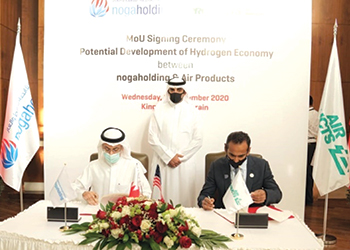
 Carpenter ... decarbonisation is an emerging opportunity
Carpenter ... decarbonisation is an emerging opportunity
Despite the apparent challenges of decarbonisation, the global shift towards sustainability should be seen as an opportunity for the region's oil and gas industry, Jonathan Carpenter, Vice President of New Energy Services at Petrofac tells OGN
Let’s be frank. The world is getting ever more serious about decarbonisation.
As extreme weather events become more frequent, environmental campaigners become more vigilant, the public mood becomes more determined, and the investment community becomes more discerning, politicians and businesses alike are making firm commitments to a low-carbon future – and, ultimately, a zero-carbon future.
In facing-up to the reality of needing more energy at lower carbon intensities, almost every business and every economy will need to make significant adjustments. But, here in the Middle East, you could easily take the view that the challenges will be magnified – after all, these are hydrocarbon-oriented economies and, either directly or indirectly, a large proportion of the region’s business community continues to be fuelled by oil and gas.
I would take a different view.
Oil and Gas is not going to disappear anytime soon. But the way the sector operates will quickly evolve. Adjacent opportunities will soon emerge. And, judging by the tone being set by the region’s governments, I firmly believe that the region and its energy industry could take a leadership role in the coming energy transition.
CLEAR REGIONAL LEADERSHIP
The first thing to acknowledge is the determination among the region’s governments and national oil companies to reduce carbon intensities.
In the United Arab Emirates, for example, Energy Strategy 2050 seeks to increase the contribution of clean energy in the total energy mix from 25 per cent to 50 per cent, and to reduce the carbon footprint of power generation by 70 per cent by 2050. This is driven, not just by a desire to do good, but also by compelling economic forces. For example, the International Renewable Energy Agency (Irena) calculates that, if renewables were to make up just 10 per cent of the country’s total energy mix and 25 per cent of its power generation, the annual savings could reach $1.9 billion.
In Saudi Arabia, meanwhile, the aim is for renewable energy to account for 50 per cent of its power generation by 2030, equating to 60 gigawatts-worth of generating capacity. And the Oil and Gas Climate Initiative (OGCI), which counts Saudi Aramco as one of its founding members, aims to reduce the collective average carbon intensity of member companies’ aggregated upstream oil and gas operations to between 20 kg and 21 kg CO2e/boe by 2025, from a collective baseline of 23 kg CO2e/boe in 2017.
Oman has similar ambitions. By 2040, the Sultanate intends to generate 30 per cent of its power from renewable sources, with 21 per cent coming from solar, 6.5 per cent from wind and 2.5 per cent from waste.
This, you could say, is the mood music for the region. Most national governments have set-out an environmental vision, backed-up by clear commitments. And these are complemented by a number of regional activities, such as the Pan-Arab Clean Energy Initiative (PACE) which is committed to increase the region’s installed renewable power generation capacity to 80 gigawatts by 2030.
COMBINATION OF ASSETS AND EXPERTISE
 |
Petrofac's New Energy Services is dedicated to supporting renewable and low-carbon projects |
When you get changes of this scale, you also get commensurate business opportunities. And, given its location, its geology, and its innate skillset, the region here ought to be a big beneficiary.
Let’s start with the climate. It’s sunny. Very sunny. And that translates into massive potential for generating low cost, abundant electricity which, in turn, opens up new economic and growth opportunities. Right now, the storage and transfer of electricity remains an issue. But with advancements in battery and other storage technologies, as well as more flexible grids, comes the potential for the decarbonisation of transportation, electricity generation, and seawater desalination, the latter being one of the largest energy consumers in the entire region.
Similarly, the Middle East is perfectly positioned for the production of green hydrogen (whereby, using solar or wind energy, hydrogen gas is extracted from seawater). This hydrogen can then be used as a clean fuel for heating industrial complexes or adding to conventional gas networks. It can also be converted to ammonia for use in shipping which, in turn, would help to decarbonise that sector. And it could be a way to channel excess renewable power – for use when the sun isn’t shining or the wind isn’t blowing.
Another opportunity is carbon capture, utilisation and storage (CCUS). The region has a number of existing reservoirs, for example in Abu Dhabi, which are ideally suited for using CO2 in enhanced oil recovery, or even for storage. In the short-to-medium term, these technologies could allow the oil and gas industry to extend field and infrastructure life. And, eventually, the region could become a vast CO2 sink, where the world’s greenhouse gasses are imported for safe underground storage.
Meanwhile, we also have Direct Air Capture with Carbon Storage (DACCS), using technologies such as Carbon Engineering’s, which, as its name suggests, captures CO2 directly from the atmosphere. An immediate application could come in a country like Saudi Arabia, where oil production already benefits from very low levels of CO2 intensity. By using DACCS, it could be possible to completely decarbonise the oil production process or be used to abate the emissions of industries where the challenge of capturing emissions at source (such as Aviation) is impossible or uneconomic otherwise.
Finally, with a growing population and burgeoning activity, there is the potential to investigate the potential for fuel-from-waste technologies. Instead of being sent to landfill, urban waste and used cooking oil can be chemically processed to produce sustainable diesel, jet or marine fuels helping these hard-to-decarbonise sectors to get their CO2 footprint down. One such project is already underway in Oman between Greenfuels and Wakud International which will produce 7,000t/year of biodiesel from used cooking oil.
A LARGE SCALE EMERGING OPPORTUNITY
Of course, all of this is easier said than done. To deliver an energy transition of this scale, it will be necessary to design, build and safely operate an enhanced energy infrastructure across the region. The great thing is that so many of the requisite skills and capabilities already exist within today’s oil and gas industry. Equally, a proportion of existing energy facilities can be evolved and repurposed for techniques like carbon capture and their operations decarbonised through the use of solar for power generation.
As an industry, we can’t pretend we are able to do it all on our own. We need to forge new partnerships, for example with utility companies and private developers, work with new technologies, and partner with investors to raise the billions of necessary dollars and develop new economic models.
This is exactly what Petrofac is envisaging with New Energy Services, a dedicated team to support renewable and low-carbon projects, which takes our world-class engineering, design, EPC delivery, and operations and maintenance capabilities and adapts and modifies them for these new opportunities. We have already had some success, working on vast offshore wind projects (like Hollandse Kust Zuid wind farms off northern Europe), innovative carbon capture schemes (like the Acorn project in the UK), and exciting green hydrogen initiatives (like the Arrowsmith project in Australia). We have also been working with traditional oil and gas clients globally, helping them to decarbonise their existing operations. And, while much of this activity may be implemented elsewhere in the world, the Petrofac knowhow being deployed resides right here in the Middle East and we see enormous potential in our home market.
It’s still a relatively small part of our total business. But it’s a rapidly growing part. By embracing the energy transition, we have every reason to believe in a bright future – one that presents significant opportunity and can see the region build on its status as the clear leader of the global energy sector.















































































